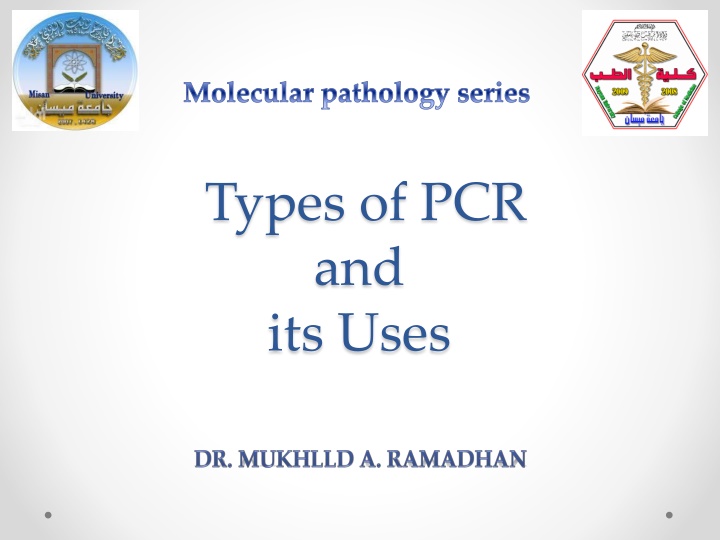
Types of PCR and Their Applications in Molecular Pathology
Explore the diverse types of PCR techniques including Conventional PCR, Real-time PCR, Multiplex PCR, Nested PCR, Reverse Transcription PCR, Methylation-specific PCR, and Hot Start PCR. Learn about their principles, applications, and significance in molecular pathology.
Download Presentation

Please find below an Image/Link to download the presentation.
The content on the website is provided AS IS for your information and personal use only. It may not be sold, licensed, or shared on other websites without obtaining consent from the author. If you encounter any issues during the download, it is possible that the publisher has removed the file from their server.
You are allowed to download the files provided on this website for personal or commercial use, subject to the condition that they are used lawfully. All files are the property of their respective owners.
The content on the website is provided AS IS for your information and personal use only. It may not be sold, licensed, or shared on other websites without obtaining consent from the author.
E N D
Presentation Transcript
Molecular pathology series Types of PCR and its Uses
Types of PCR Conventional PCR Real time PCR
1. Variants of conventional PCR A. Multiplex PCR. B. Nested PCR. C. Reverse transcription PCR. D. Methylation specific PCR. E. Hot start PCR.
A simple thermocycling protocol 1X 35X 1X 94 C 94 C 72 C 72 C 3 min 1 min 1 min 5 min 55 C Initial denaturation of DNA 45 sec denaturation extension 4 C Final extension annealing hold
A. Multiplex PCR Amplifies multiple different regions of DNA at one time. Multiple primer pairs are used in one reaction. Uses Several targets can be analyzed in one specimen.
B. Nested PCR Two pairs of primers are used in this type. o The first primers set ( outer primers ) o second primer set ( inner primers ) Uses to improve amplicon yield and specificity. Detection of pathogens that occur with very few amount.
C. Revers transcription PCR Revers transcriptase enzyme. Uses: Detection of RNA virus like (HCV). Detection of other M.O. through targeting of their Ribosomal RNA.
D. Methylation-specific PCR is used on genomic DNA to determine if the CpG islands within the promoter of a gene are methylated on the cytosine residue (blocking the gene expression in the cell ) or unmethylated (potentially allowing gene expression). For example, silenced genes on X chromosomes are methylated, as are the promoters of tumor suppressor genes in many cancers.
E. Hot start PCR This technique preventing Taq from extending primers until a temperature of 60 80 C is reached. Uses Prevents formation of primer dimers prevents the non-spesific binding of primers to non-target DNA segment.
